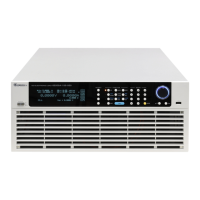Remote Operation
Character Data Formats 4.2.3
For command statements, the <NRf+> data format permits entry of required characters. For
query statements, character strings may be returned in either of the forms shown in the
following table. It depends on the length of the returned string.
Table 4-4
Character Response Data. They permit the return up to 12 characters.
Arbitrary ASCII Response Data. They permit the return of undelimited 7-bit
ASCII. This data type is an implied message terminator (refer to Separators
and Terminators).
Arbitrary Block Data Format 4.2.4
The arbitrary block data returned by query command may take either of the following forms:
<DLABRD> Definite Length Arbitrary Block Response Data:
The <DLABRD> is formatted as:
#<x><yy...y><byte1><byte2><byte3><byte4>…<byteN><RMT>
Where,
<x> is the number of characters in <yy…y>.
<yy…y> is the number of bytes to transfer.
For example, if <yy…y> = 01024, then <x> = 5 and <byte1><byte2><byte3>…<byte1024>
<ILABRD> Indefinite Length Arbitrary Block Response Data:
The <ILABRD> is formatted as:
#<0><byte1><byte2><byte3><byte4>…<byteN><RMT>
Separators and Terminators 4.2.5
In addition to keywords and parameters, GPIB program statements require the following:
Data Separators:
Data must be separated from the previous command keyword by a space. This is shown in
examples as a space (CURR 3) and on diagrams by the letters SP inside a circle.
Keyword Separators:
Keywords (or headers) are separated by a colon (:), a semicolon (;), or both. For example:
LOAD:SHOR ON
MEAS:CURR?;VOLT?
CURR:STAT:L1 3;:VOLT:L1 5

